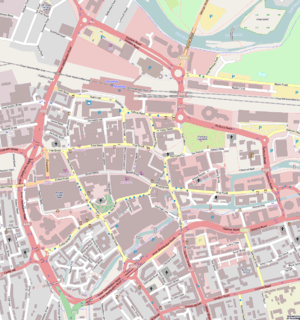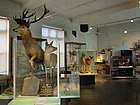Reading Museum
Reading Museum (run by the Reading Museum Service) is a museum of the history of the town of Reading, in the English county of Berkshire, and the surrounding area. It is accommodated within Reading Town Hall, and contains galleries describing the history of Reading and its related industries, a gallery of artefacts discovered during the excavations of Calleva Atrebatum (Silchester Roman Town), a copy of the Bayeux Tapestry, finds relating to Reading Abbey and an art collection.[1]
.jpg) The entrance to the Reading Museum within Reading Town Hall | |
 Location within Reading Town Centre | |
| Established | 1883 |
|---|---|
| Location | Reading, Berkshire, UK |
| Coordinates | 51.4572°N 0.9702°W |
| Type | Local museum |
| Public transit access | Reading railway station |
| Website | readingmuseum.org.uk |
History of the museum
Reading Town Hall was built in several phases between 1786 and 1897, although the principal facade was designed by Alfred Waterhouse in 1875. In 1879, the foundation stone was laid for a new wing containing a library and museum, and the museum duly opened in 1883. Three art galleries were added in further extension in 1897.[2]
In 1975, the civic offices moved out of the Town Hall to Reading Civic Centre. They were followed in 1985 by the Reading Central Library which left only the museum and the concert hall in use. After some debate, plans to demolish the Town Hall and replace it with a new cultural centre were abandoned, and in 1986 refurbishment of the building started. The museum was closed for renewal in 1989, reopening in stages from 1993 (the Reading: People & Place gallery) to 2000.
Principal galleries
Story of Reading Gallery
This documents Reading's history, from its origins as a Saxon settlement in the 6th century up to today, with a mixture of oral history presentations, interactive displays and a mix of real objects from the period. There is an emphasis on Reading Abbey.[3]
The Silchester Gallery
The gallery features many archeological finds from the excavations conducted at the nearby Calleva Atrebatum (Silchester Roman Town) together with explanatory models and other information on life in the Roman town. This includes the bronze Silchester eagle that was immortalised by Rosemary Sutcliff in her children’s book The Eagle of the Ninth, first published in 1954.
The Roman town of Calleva Atrebatum was undiscovered until excavated in the 1860s at which time the finds included jewellery, fine glass and pottery, sculpture, mosaics, iron tools and coins. Many items found during the excavation are displayed in the gallery, including the famous Silchester eagle; the Iron Age Silchester Horse; the damaged head of Seraphis, and a model of the Roman town.
Atrium
This space provides seating around a Roman pavement mosaic, from the Silchester site and thought to be from a 4th century Christian church there, and wall displays of two "huge"[4] > mosaics, also from Silchester, juxtaposed with ceramics of Alan Caiger-Smith produced at his Aldermaston Pottery.
The Bayeux Gallery


This gallery contains the UK's only woven full-size copy of the famous Bayeux Tapestry (made by the Leek Embroidery Society in 1885 - 35 skilled Victorian women embroiderers), together with information on the history of Saxon migration and Viking raids in the local area.[5]
The replica of the Tapestry is 70 metres long and, like the original, depicts the events leading up and including the Battle of Hastings in 1066. In addition, the Bayeux Gallery also explores the background and impact of the Norman Conquest by William I. His youngest son Henry I, founded Reading Abbey in 1121.
The Green Space

The Gallery explains the geology and natural history of the Reading area through a large display of specimens. Exploring the history of the Reading area from 400 million years ago to the present day, it explains what was in the area before people existed and how Reading's landscape and environment has developed and been influenced by human activity since the Stone Age.[6]
The Gallery also shows the animals and plants living in the Reading area today. Highlights in the display include a complete Iron Age dog skeleton discovered and excavated at Blewburton hillfort; and a royal red deer stag which was donated to the Museum by George V from the royal herd at Windsor Great Park.[6]
Huntley & Palmers Gallery

Explains the history of the biscuit-making industry that was once one of the mainstays of the Reading economy, with special emphasis on the Huntley and Palmers company, Reading's world famous biscuit makers. The display charts how how Huntley & Palmers pioneered the mass production of biscuits and explains why Reading became known as the 'Biscuit Town'.[7]
The display shows what factory life was like for Huntley & Palmers' thousands of employees explained through oral recordings, photographs and historic film, including the earliest surviving film of a British factory in action. Highlights of the display include about 300 decorative biscuit tins as well as advertising material and other artefacts; an African thumb piano crafted from a Huntley & Palmers biscuit tin; a biscuit supplied to Captain Scott's final Antarctic expedition, and an example of the rude ‘Kate Greenaway’ biscuit tin that continues to embarrass the company today.[7]
The Windows Gallery
This Gallery is named The Windows Gallery as it is a 'window' on the Museum's wide collection of sculpture and decorative art, ranging from Romanesque stones from the 12th-century from Reading Abbey to modern pieces by Rodin and Epstein.
Originally, this section of the Museum housed the Reading School of Art and as such was designed to be well-lit by natural daylight from the windows on either side. Highlights of the collection include: Romanesque capitals from Reading Abbey; sculpture by Rodin, Epstein and Gibbings, and Delftware plates and other ceramics.[8]
The Sir John Madejski Art Gallery
This is a recreation of the museum's original Victorian era art gallery and houses changing exhibitions of artworks. It is named after John Madejski, the chairman of Reading F.C..
The Exhibition Gallery
Designed to house changing exhibitions, both from the museum's collection and external sources. As an example, in late 2004, the gallery contained an exhibition on the history of the Reading Festival.
Access
The museum is free to visit. As of February 2020, it is open from 10:00 to 16:00 on Tuesday to Friday, 10.00 to 17.00 on Saturdays, and closed all day Monday and Sunday, with exceptions for holidays.[9]
Charitable
Reading Foundation for Art was set up in 1974 with the ambition of building an art collection to enrich the lives of the local residents and enhance the cultural fabric of Reading and the surrounding areas. It now has a collection of over 150 works on permanent loan to Reading Museum and is a registered Charity.
References
- Reading Museum, Culture24, UK.
- "Reading Town Hall (townhall-36.pdf)". Reading Museum Service. Archived from the original on 2015-10-09. Retrieved 2015-10-02.
- https://www.readingmuseum.org.uk/your-visit/permanent-galleries/story-reading-gallery
- https://www.readingmuseum.org.uk/your-visit/permanent-galleries/atrium
- Britain's Bayeux Tapestry at the Reading Museum, Reading Museum Service, Reading Borough Council, UK.
- The Green Space Gallery - Museum of Reading website
- The Huntley and Palmers Gallery - Museum of Reading website
- The Window Gallery - Museum of Reading website
- https://www.readingmuseum.org.uk/opening-times